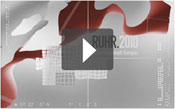The Ruhr region, Germany's former industrial heartland with its coal mines, coking plants and steelworks, is now a cultural conurbation full of contrasts in the heart of the Europe. Places associated with hard physical labour have been transformed into recreational attractions where culture thrives, including the UNESCO World Heritage Zollverein coal mine and renaturalised landscapes such as Duisburg-Nord Industrial Landscape Park. 1,000 industrial monuments, 200 museums, 100 arts centres, 120 theatres, 100 concert venues, 250 festivals and fairs - with an even longer list during 2010 - give visitors from around the world the chance to experience the European Capital of Culture RUHR.2010 for themselves. The region is now home to 5.3 million people from an incredible 170 countries.
European Capital of Culture RUHR.2010
In 2010 the Ruhr is the European Capital of Culture under the official name of 'RUHR.2010, Essen for the Ruhr'. Never before has the title been held by an entire region - in this case a conurbation of 53 towns and cities in western Germany near the border with the Netherlands. Hundreds of highlights and events in captivating locations will reveal a surprising new side to the region.
The Ruhr region, Germany's former industrial heartland with its coal mines, coking plants and steelworks, is now a cultural conurbation full of contrasts in the heart of the Europe. Places associated with hard physical labour have been transformed into recreational attractions where culture thrives, including the UNESCO World Heritage Zollverein coal mine and renaturalised landscapes such as Duisburg-Nord Industrial Landscape Park. 1,000 industrial monuments, 200 museums, 100 arts centres, 120 theatres, 100 concert venues, 250 festivals and fairs - with an even longer list during 2010 - give visitors from around the world the chance to experience the European Capital of Culture RUHR.2010 for themselves. The region is now home to 5.3 million people from an incredible 170 countries.
The Ruhr region, Germany's former industrial heartland with its coal mines, coking plants and steelworks, is now a cultural conurbation full of contrasts in the heart of the Europe. Places associated with hard physical labour have been transformed into recreational attractions where culture thrives, including the UNESCO World Heritage Zollverein coal mine and renaturalised landscapes such as Duisburg-Nord Industrial Landscape Park. 1,000 industrial monuments, 200 museums, 100 arts centres, 120 theatres, 100 concert venues, 250 festivals and fairs - with an even longer list during 2010 - give visitors from around the world the chance to experience the European Capital of Culture RUHR.2010 for themselves. The region is now home to 5.3 million people from an incredible 170 countries.
- Further information on Ruhr.2010
- Official website to RUHR.2010
- Tourist information on the Ruhr region
Travel Planner
Select an option...






